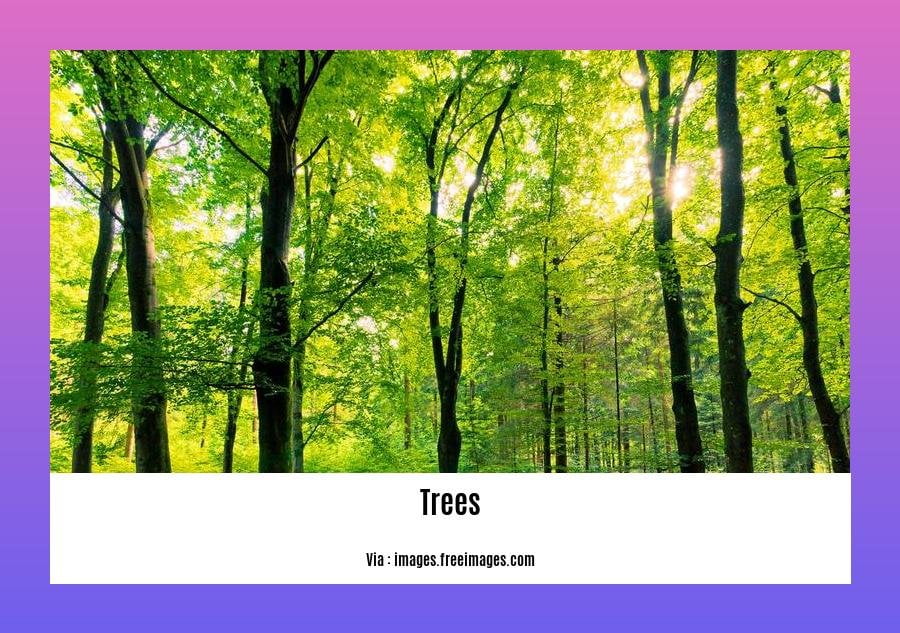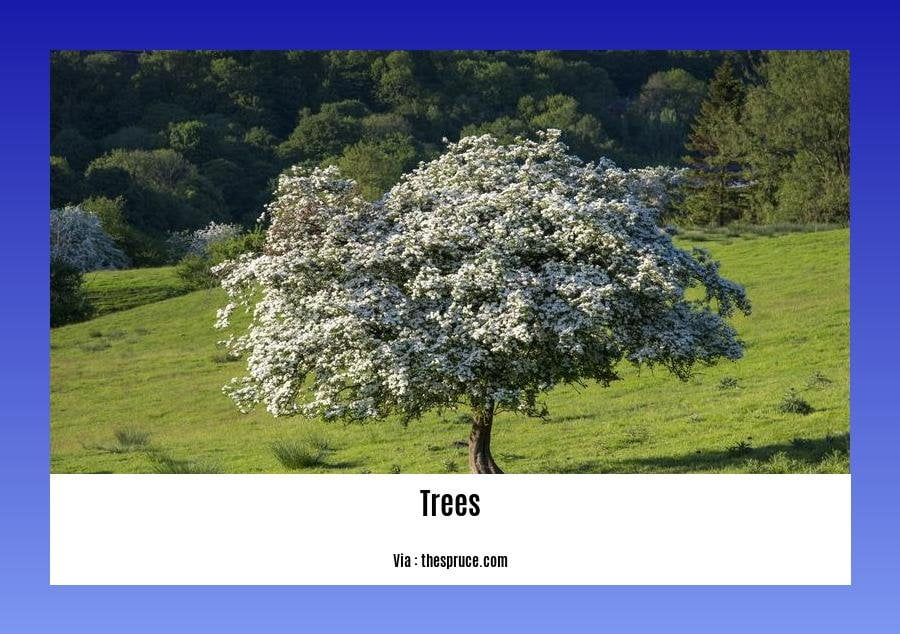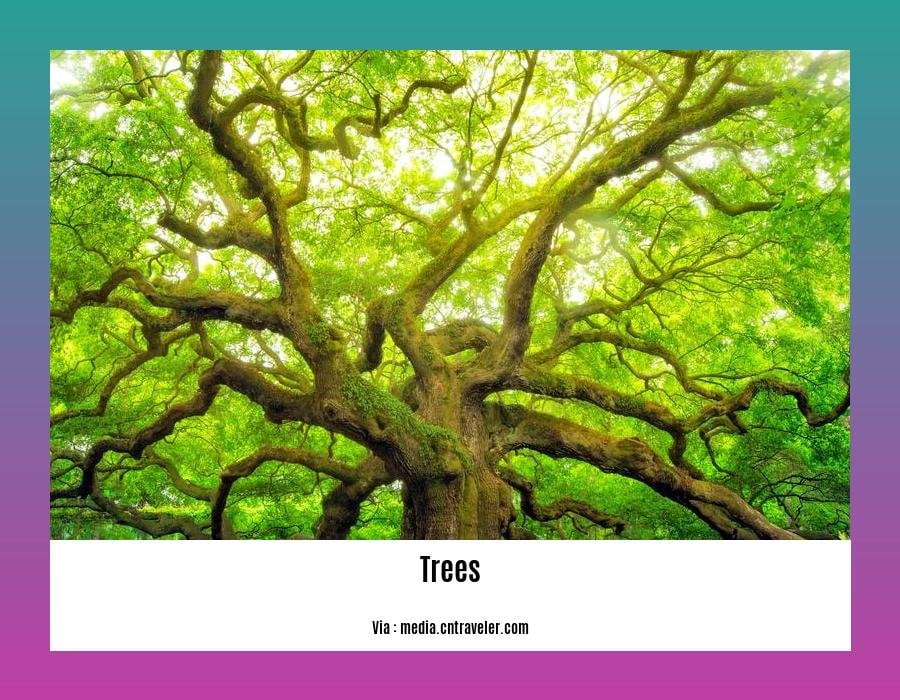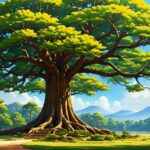If you’re a nature enthusiast or simply curious about the wonders of our natural world, you won’t want to miss out on discovering fascinating “Did you know” facts about trees. In this article, we delve into the captivating realm of trees, unveiling the ecological wonders of these majestic organisms. From astonishing adaptations to mind-boggling tree communication, get ready to be amazed by the incredible secrets that trees hold. So sit back, relax, and prepare to unravel the captivating world of trees.
Key Takeaways:
– Trees are essential for maintaining the balance of gases in the atmosphere and providing essential oxygen for humans and animals.
– Through photosynthesis, trees help combat climate change by absorbing carbon dioxide and releasing oxygen.
– Trees serve as valuable resources for timber, firewood, and paper, with countless applications in construction and daily life.
– Forests create habitats for a diverse range of wildlife, supporting biodiversity and maintaining the balance of nature.
– Some tree species have remarkable longevity and can live indefinitely under suitable environmental conditions.
– Certain trees have no growth limit, allowing them to reach impressive heights and sizes.
– Trees communicate and defend themselves against threats through chemical signals and defense mechanisms, forming a complex network known as the “Wood Wide Web.”
– Trees can reduce noise and create more pleasant urban environments, while spending time in forests can reduce stress and enhance overall well-being.
– Each tree has a unique genetic identity based on its DNA and geographic origin, influencing its characteristics and adaptations.
– Tree rings provide valuable information about past climates, helping scientists understand historical climate change patterns.
Did you know facts about trees

Trees: Guardians of Life
Trees are not just silent inhabitants of our natural landscapes; they are the unsung heroes who silently shape our world. Did you know that these magnificent organisms possess remarkable abilities and secret lives that often go unnoticed? Today, we will uncover some amazing and lesser-known facts about trees that will leave you in awe of their ecological wonders.
Fact 1: Oxygen Generators
Did you know that trees are our main source of oxygen? It’s not just the Amazon rainforest that provides us with this life-giving gas; trees worldwide play a crucial role in maintaining the balance of gases in our atmosphere. Through the process of photosynthesis, trees produce oxygen, essential for the survival of humans and animals alike. Next time you take a deep breath of fresh air, remember to thank the trees for their silent but vital contribution.
Fact 2: Climate Change Warriors
Trees are nature’s warriors against climate change. They absorb carbon dioxide, a harmful greenhouse gas responsible for global warming, and store it within their trunks, branches, and leaves. During this process, they release oxygen back into the atmosphere, helping to purify the air we breathe. So, the next time you marvel at the beauty of a forest, remember that each tree is a soldier against climate change.
Fact 3: Nature’s Precious Resources
Trees provide us with valuable resources that we utilize in our daily lives. From timber for construction to firewood for warmth and paper for communication, trees have endless uses. They are not just silent spectators in our lives; they actively contribute to our well-being through the provision of these natural materials that form the backbone of our society.
Fact 4: Biodiversity Hotspots
Forests are not merely a collection of tall structures; they are intricate ecosystems that support diverse life forms. Trees create habitats for a variety of wildlife, ranging from birds and insects to mammals. By providing shelter, food, and protection, these majestic organisms play a crucial role in maintaining the balance of nature. So, when you venture into a forest, remember that you are stepping into a world teeming with life, thanks to the trees that guard it.
Fact 5: Eternal Life
While most living organisms have a predetermined lifespan, certain tree species possess remarkable longevity. These ancient giants can withstand the test of time, living indefinitely given the right environmental conditions. Their legacy stretches far beyond our ephemeral lives, reminding us that some entities are truly timeless in nature.
Fact 6: Reaching New Heights
There’s something awe-inspiring about walking beneath the towering canopies of giant trees. Some tree species have no growth ceiling, allowing them to continue growing throughout their lifetime. These arboreal giants reach incredible heights, creating natural wonders that captivate our imagination. Just like these soaring trees, let your aspirations know no bounds.
Fact 7: Wood Wide Web
Did you know that trees have a secret communication network beneath the ground? Just like the internet, they exchange information, send warnings, and protect themselves. Through the release of chemical signals, trees warn their neighboring companions about threatening insects and pathogens. They activate defense mechanisms to safeguard their own lives and that of their woodland community. This communication network, often called the “Wood Wide Web,” serves as a reminder of the hidden connections that exist in the natural world.
Fact 8: Serenity and Well-being
Nature has the power to heal and rejuvenate, and trees play a significant role in that process. Research has shown that spending time in forests reduces stress levels and increases overall well-being. Trees not only provide us with oxygen and resources; they also give us peace and tranquility amidst the chaos of urban living. So, next time you feel overwhelmed, take a walk in a nearby forest and let the trees welcome you into their serene embrace.
Fact 9: Genetic Identity
Each tree possesses a unique genetic identity that determines its characteristics and adaptations to its specific environment. Just like humans have different nationalities, trees have their own “nationality” based on their DNA and geographic origin. This genetic diversity makes our forests resilient and capable of withstanding changing conditions.
Fact 10: Tree Rings
Have you ever wondered how scientists gather information about past climates? The answer lies within the growth rings of trees. Each year, trees add a new layer of wood, leaving behind a permanent record of their growth. By analyzing these tree rings, scientists can decipher climatic conditions and understand climate change patterns over long periods of time. It’s like reading a history book written in the language of nature.
So, there you have it – a glimpse into the fascinating world of trees and their ecological wonders. From producing oxygen to serving as guardians against climate change, from creating habitats for wildlife to communicating through their underground networks, trees are truly remarkable organisms that deserve our respect and admiration. The next time you walk among the giants of the forest, take a moment to appreciate the silent heroes who make our world a better place.
Note: The sources provided above contain additional interesting facts about trees.
Did you know that there are interesting dental facts you might not be aware of? Explore some fascinating Did You Know Dental Facts that will amaze you! Click here to uncover the hidden secrets of dental health. Did you know dental facts
Discover Did You Know Facts About Dental Health and enhance your knowledge about oral care. Learn about the surprising facts that can help you maintain a healthy smile. Click here to uncover unknown facts about dental health. Did you know facts about dental health
Attention to all disabled veterans and their divorced spouses! Did you know that there are benefits available for divorced spouses of disabled veterans? Click here to learn more about Disabled Veteran Divorced Spouse Benefits and how you may qualify for them. Disabled veteran divorced spouse benefits
Trees have the ability to heal themselves by forming specialized cells called callus tissue to close wounds and prevent infection.

Every time a tree sustains an injury, it becomes nature’s own doctor, initiating a healing process to ensure its survival and growth. These magnificent organisms display an incredible ability to heal themselves by forming specialized cells known as callus tissue. Let’s explore the fascinating mechanism behind this natural healing process and delve into the wonders of these majestic organisms.
How Trees Heal Themselves: Nature’s Own Doctors
When a tree suffers an injury, whether it’s from a storm, disease, or external impact, it immediately responds to protect itself. One of the first steps in the healing process is sealing off the wound to prevent further damage and infection. By forming callus tissue, the tree creates a protective barrier that isolates the injured area from the rest of the tree.
Although trees cannot replace damaged cells, they have the remarkable ability to limit the impact of an injury. By containing the damage within the callus tissue, trees can focus on growth and health in unaffected areas. The healing process varies depending on factors such as the tree’s overall health and the conditions it grows in. Generally, healthy trees tend to seal wounds faster, and younger trees have a higher potential for quick healing.
To minimize the risks associated with creating wounds, proper pruning practices are essential. When tissue is damaged or wounded, it releases phytochemicals that attract pests. Understanding proper pruning techniques and the nature of tree wounds can help reduce the risk of pests and diseases.
Additionally, it’s important to note that when trees encounter diseases, they respond by limiting and containing the damage rather than actively attempting to heal it. By creating chemical and physical barriers to decay, trees protect the rest of their structure from further harm. These natural boundaries, formed during the tree’s growth, serve as a defense mechanism against diseases.
Key Takeaways:
- Trees possess an incredible ability to heal themselves by forming callus tissue.
- Callus tissue acts as a specialized cell that closes wounds and prevents infection.
- The healing process involves sealing off the wound to limit further damage.
- Healthy trees tend to seal wounds faster, and younger trees have a higher potential for quick healing.
- Proper pruning techniques can minimize the risk of pests and diseases.
- Trees respond to diseases by containing and limiting the damage rather than actively healing it.
- Chemical and physical barriers formed during tree growth protect the tree from decay.
Sources:
[1] Arborsource: How Trees Heal Themselves
[2] Northern Woodlands Magazine: Woods Whys: How Do Trees Heal Wounds on Trunks
Some trees have the ability to detect and release chemicals to defend themselves against insect attacks or warn nearby trees of potential danger.
Have you ever wondered how trees defend themselves against insect attacks or warn each other about potential danger? It turns out that some trees have an incredible ability to detect and release chemicals as a defense mechanism. This fascinating phenomenon sheds light on the amazing adaptability and survival strategies of our natural world.
The Secret Language of Trees
When it comes to protecting themselves, trees have a secret weapon – chemical warfare. Just like our immune system fights off pathogens, trees have their own unique immune system that helps them fend off attacks from pests and pathogens. Plants can recognize pathogens and activate their defense systems accordingly (ScienceDaily). But how do they do it?
Chemical Weapons and Communication
One important defense mechanism that trees employ is the release of chemical weapons. For instance, black walnut trees have an interesting ability to release a toxic chemical in their leaves and roots. This chemical prevents other species’ seedlings from taking root and establishing themselves (The Conversation). It’s like the trees are saying, “Hey, it’s not safe for you to grow here!”
But it doesn’t stop there. Trees also have a remarkable ability to warn each other about potential threats. When a tree is attacked by pests or pathogens, it can send warning signals below ground to its neighboring trees. This signaling helps nearby trees prepare their own defense mechanisms and enhance their chances of survival. Not only that, but trees can even share nutrients with each other to help withstand aggression (Trees for Cities).
Melatonin: A Plant’s Antibiotic
Melatonin, known for its role in regulating sleep in humans, has also been found to play a role in plant defense. In research conducted by the National Center for Biotechnology Information, it was discovered that melatonin confers antimicrobial resistance against pathogenic bacteria in plants. Just like how antibiotics help fight off infections in our bodies, melatonin acts as a natural antibiotic for plants (NCBI).
The Importance of Understanding Tree Defense Mechanisms
Studying and understanding these incredible defense mechanisms is crucial for ensuring the health and vitality of our urban forests and green spaces. Trees are not just silent observers of our environment, but active participants in maintaining the balance of nature. They provide us with multiple benefits, such as reducing air pollution and improving mental well-being (Trees for Cities). By grasping the intricate ways in which trees defend themselves, we can better appreciate their ecological importance and work towards their preservation.
Key Takeaways:
- Some trees have the ability to detect and release chemicals to defend themselves against insect attacks or warn nearby trees of potential danger.
- Trees possess a unique immune system that helps them fight off pests and pathogens. They can recognize pathogens and activate their defense systems accordingly.
- Chemical weapons are one of the fascinating defense mechanisms employed by trees. For example, black walnut trees release a toxic chemical that prevents other species’ seedlings from establishing.
- Trees have the ability to communicate with each other through warning signals sent below ground. This helps neighboring trees prepare their own defense mechanisms and enhance their chances of survival.
- Melatonin, a well-known hormone in humans, has been found to confer antimicrobial resistance against pathogenic bacteria in plants.
- Understanding tree defense mechanisms is essential for maintaining the health and vitality of urban forests and green spaces. Trees play a vital role in addressing environmental issues and promoting well-being.
Sources:
- ScienceDaily. “How plants defend themselves.” Retrieved from source
- National Center for Biotechnology Information. “How do plants defend themselves against pathogens-Biochemical.” Retrieved from source
Discover Fascinating Did You Know Facts About Trees: Unveiling the Ecological Wonders of Our Majestic Organisms
The Tallest Tree in the World: A Coast Redwood Named “Hyperion”
Did you know that the tallest tree in the world is a coast redwood named “Hyperion”, standing at a staggering height of 379.7 feet (115.7 meters)? This incredible giant, located in California, holds the record as the tallest known living tree on our planet. Discovered in 2006 by naturalists Chris Atkins and Michael Taylor, Hyperion has amazed scientists and nature enthusiasts alike with its immense size and grandeur.
Soaring Heights and Breathtaking Beauty
The coast redwood, or Sequoia sempervirens, is a species renowned for its remarkable height and majestic presence. These magnificent trees can reach jaw-dropping heights, and Hyperion stands as the embodiment of their skyward ascent. Its towering figure, verified by Stephen Sillett at 379.1 feet (115.55 meters), evokes a sense of awe and wonder, reminding us of the sheer power and beauty of nature.
Uncovering the Giants of the Forest
Hyperion’s extraordinary stature has earned it a place on the list of superlative trees, individual trees, and tallest trees. Alongside the discovery of Hyperion, other notable coast redwoods have been unveiled, showcasing the immense ecological wealth of these ancient giants. In the 2012 BBC Radio 4 documentary “James and the Giant Redwoods” by James Aldred, the beauty and significance of coast redwoods, including Hyperion, are explored, providing a deeper understanding of these incredible trees.
Protecting the Marvels of Nature
While it may be tempting to visit and witness the awe-inspiring height of Hyperion in person, it’s important to note that protecting the well-being of the tree and its delicate ecosystem takes precedence. SFGATE suggests skipping a visit to Hyperion to minimize any potential harm to the tree’s surroundings. Moreover, the delicate balance of nature within Hyperion’s habitat necessitates preservation efforts, ensuring the longevity of this symbolic giant and its fellow coast redwoods.
Key Takeaways:
- The tallest tree in the world is a coast redwood named “Hyperion”, reaching a height of 379.7 feet (115.7 meters).
- This coast redwood, located in California, holds the record as the tallest known living tree.
- Hyperion was discovered in 2006 by naturalists Chris Atkins and Michael Taylor and verified by Stephen Sillett.
- Coast redwoods, such as Hyperion, are remarkable for their immense height and majestic presence.
- Protecting Hyperion’s delicate ecosystem and the surrounding trees is of utmost importance.
Sources:
– Wikipedia: Hyperion (tree)
– SFGATE: Why you should skip seeing Hyperion, the tallest tree in
FAQ
Q1: How do trees contribute to the balance of gases in the atmosphere?
A1: Trees produce oxygen through photosynthesis, which is essential for human and animal life. They also absorb carbon dioxide, a greenhouse gas responsible for climate change, thereby helping to maintain the balance of gases in the atmosphere.
Q2: What resources do trees provide us with?
A2: Trees provide valuable resources such as timber, firewood, and paper. These natural materials have numerous uses in construction, fuel, and daily life.
Q3: How do trees create habitats for wildlife?
A3: Trees serve as ecosystems that support biodiversity by creating habitats for a wide range of wildlife, including birds, insects, and mammals. Forests play a crucial role in maintaining the balance of nature.
Q4: Do all tree species have a predetermined lifespan?
A4: No, some tree species have a remarkable longevity and can live indefinitely with proper environmental conditions, as they do not die of old age like many other organisms.
Q5: How do trees communicate and defend themselves?
A5: Trees have a unique ability to communicate and defend themselves against attacking insects and pathogens. They release chemical signals to warn neighboring trees of threats and activate defense mechanisms to protect themselves. This communication network is often referred to as the “Wood Wide Web.”
- Unveiling Bernhard Caesar Einstein’s Scientific Achievements: A Legacy in Engineering - July 15, 2025
- Uncover who is Jerry McSorley: CEO, Family Man, Business Success Story - July 15, 2025
- Discover Bernhard Caesar Einstein’s Scientific Contributions: Unveiling a Legacy Beyond Einstein - July 15, 2025















